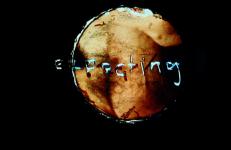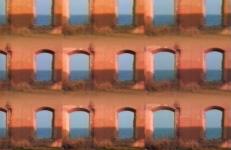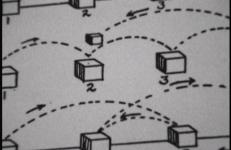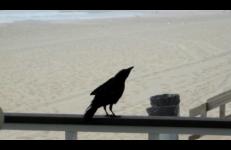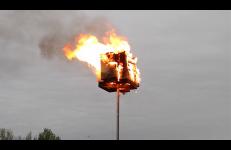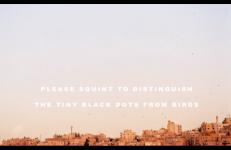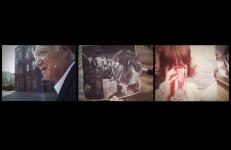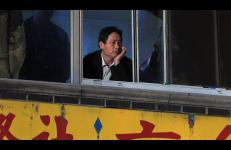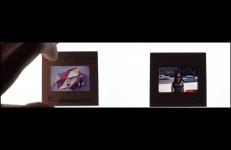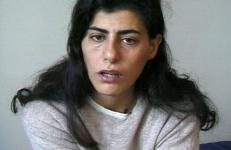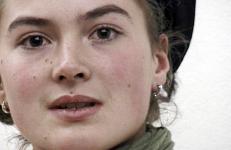Directed by artist and filmmaker Tiffany Sia, The Sojourn imagines a restless landscape film in Taiwan. Visiting scenic locations shot by King Hu, the short experiments with the road movie genre and its intersection with the martial arts epic. Sia meets actor Shih Chun, who played the protagonist in Hu’s Dragon Inn, Touch of Zen and other wuxia films, as he guides the quest to re-encounter the iconic landscapes where Dragon Inn was shot. He counsels on the perfect conditions of mist and weather.
Memory
"The title (Black Sun) is as evocative of solar eclipse as it is of the 'dark spleen' which doctors, all through Antiquity, used to attribute to melancholic and suicidal drives, especially as they affected artists. Here such drives end up striking the existence of Antonia, an opera singer whose dark beauty brings light to the film. Through discreet and elliptical staging, Laura Huertas Millán presents Antonia’s multi-faceted character.
Wittnerchrome, Exacto Knife, 1.5mm Letter Punches, Hammer, Leather Puncher
This is a feminist critique of the Oedipal complex. The filmmaker recounts an abortion she had in 2009. The aborted child survives and becomes her lover. Her subject is filmed in a private act, complicating what could be an act of the solitary.
An example of what Reeves terms “video poetics,” layered images of a deserted village in the Spanish countryside play counterpoint to poetry by Cesar Vallejo and Pablo Neruda. Using slick production techniques, Reeves marks the passing of time and human presence with a video transparency effect. What we see is a ghost of what was. Reeves’s precise editing makes for an extraordinarily fluid tape, as images seem to fly through the landscape, through past, present and future.
Shot in Naples, Vienna, and New York, Some Chance Operations explores the notion of an archival form, in this instance film, as an unstable memory receptacle that can vanish. History and how it is made is meditated upon as one of many chance operations. The filmmaker Elvira Notari, who had a film production company in Naples from 1906 to 1930, plays a significant role as an impetus for Some Chance Operations. Despite the fact that she was a prolific filmmaker, producing over sixty feature films, only three remain intact.
The Source is a Hole poses a web of loose connections and liminal associations to sculpt a treatise on transexual mourning. As a series of love letters, stories recount the authors own inception at the 1982 world’s fair, his attempt to remove a lodged tampon, his cravings for bottomless eros, and a barrage of tangential encounters, spanning the everyday, to performance reenactment, to science fiction cinema analysis and drag.
A minimal, suggestive narrative about a summer trip to the Jersey Shore, fictionalized by subtraction. The film combines still photos, moving image, and precise sound design with barely perceptible animation to create a subliminal effect, and an ambivalence about what's remembered and what's imagined.
— Liza Bear
Told through the voices of three elderly South Carolinian's who reside in the homes in which they were born, Steven Go Get Me A Switch is an oral history mapping dichotomies of gender, familial mythologies, sexuality, and belief. A heavy use of symbolism comingles with suggestions of narrative proof. The desire to be good and the impossibility of such desire becomes a sharp inaudible pitch, like a dog whistles call to violence.
The Story of Milk and Honey is a short experimental video belonging to a larger project, which includes photographs, drawings and text, detailing an un-named individual’s failure to write a love story. Through voiceover narration that weaves together images, letters, and songs, a story of defeat transpires into a journey that explores how we collect and perceive information, understand facts, history, images, and sound and where the individual is to be found in the midst of the material.
Produced with the Fundación Marcelino Botín Grant for Visual Arts Fund.
Tell Me About Your Mother investigates matrilineal lineage, domesticity and creativity. Intimate and conversational, seven female artist friends and colleagues of mine—mostly boomers—recount their mother’s creative influence upon them. Additionally, each woman discusses the unique way(s) she distinguished herself from her mother.
Commissioned by Lower Manhattan Cultural Council (LMCC) for the occasion of Eiko receiving the Sam Miller Performing Arts Award. Premiered at LMCC’s A Toast to Downtown on December 9, 2020. Shot at LMCC’s Arts Center at Governors Island.
Performer Eiko Otake.
Director/Editor Liz Sargent.
DP Minos Papas.
Production by Cyprian Films, New York.
Filmmaker Cam Archer examines and explores his ordinary, suburban neighborhood in search of hidden truths, new narratives and a better understanding of his fading, creative self. Combining heavily degraded video with personal photographs and real life neighbors, Archer re-imagines the concept of 'home video'. In an attempt to distance himself from his subjects, actress Jena Malone narrates the piece as Archer in the first person.
A personal essay about connection and disconnection, in and through different realities.
This Was Home is comprised of three channels, which present three generations of the artist’s family. On one screen Levy presents her maternal grandfather, Karl Ribstein, another shows her father, Yossi Levy, and the third presents the artist herself. Levy documented each of these protagonists on a journey back to their childhood city and to the home where they grew up, which they had not revisited since having to leave it in their childhood.
Embark on an expressive excursion into the body of a young man who’s lips issue words from his soul. Hear his passionate heart-beat, and see the wounds inflicted by bitter "truths", – but notice too his eyes that sparkle with inner strength against the "pitfalls" in life. This movie will grab you and not let go.
A man returns, after fifty years, to Chinatown to care for his dying mother. He is a librarian, a re-cataloguer, a gay man, a watcher, an impersonator. He passes his time collecting images that he puts before us – his witnesses and collaborators. Sitting in the dark, we share his cloak of invisibility, both a benefit and a curse.
The projection and screens in this installation are access points meant to connect the present to an ancestral past. Evoking the ritualism of Aztec cosmology, this experience recalls lumbreras – circular excavation holes in archeological sites, such as the recently found Tzompantli (skulls ceremonial rack) at the Templo Mayor in Tenochtitlan (Mexico City). The use of obsidian crystal as a nuclear filter in the chamber is also essential.
The projection and screens in this installation are access points meant to connect the present to an ancestral past. Evoking the ritualism of Aztec cosmology, this experience recalls lumbreras – circular excavation holes in archeological sites, such as the recently found Tzompantli (skulls ceremonial rack) at the Templo Mayor in Tenochtitlan (Mexico City). The use of obsidian crystal as a nuclear filter in the chamber is also essential.
The projection and screens in this installation are access points meant to connect the present to an ancestral past. Evoking the ritualism of Aztec cosmology, this experience recalls lumbreras – circular excavation holes in archeological sites, such as the recently found Tzompantli (skulls ceremonial rack) at the Templo Mayor in Tenochtitlan (Mexico City). The use of obsidian crystal as a nuclear filter in the chamber is also essential.
The projection and screens in this installation are access points meant to connect the present to an ancestral past. Evoking the ritualism of Aztec cosmology, this experience recalls lumbreras – circular excavation holes in archeological sites, such as the recently found Tzompantli (skulls ceremonial rack) at the Templo Mayor in Tenochtitlan (Mexico City). The use of obsidian crystal as a nuclear filter in the chamber is also essential.
This project started with an email from a stranger in 2017. The sender was the widower of the late artist Tania and he invited the filmmaker to look at her “archive.” Tania was born to Jewish parents in Poland in 1920. The family moved to Paris in the 1930s, but during the WWII they fed to Montreal, then emigrated to New York. Tania eventually became an artist. While facing many hurdles as a female artist in the 1960s and 70s, Tania vigorously created a wide range of artworks, not only paintings and three-dimensional pieces, but also public art projects.
This performative video addresses a conflict of spectatorship: dialectics relationship among memory, interpretation, and reality.
An intimate dialogue with Soha Bechara, ex-Lebanese National Resistance fighter, in her Paris dorm room. The interview was taped during the last year of the Israeli occupation, one year after her release from captivity in El-Khiam torture and interrogation center (South Lebanon) where she had been detained for 10 years—six in isolation. Revising notions of resistance, survival, and will, the overexposed image of the survivor speaks quietly and directly to the camera—not speaking of the torture, but of separation amd loss; of what is left behind and what remains.
Produced in former Yugoslavia (Bosnia-Herzegovina, Croatia, Macedonia, Serbia & Montenegro, Slovenia), Austria, USA, Canada, 1999-2003.
Vera is an assisted self-portrait of consumption. The subject is a woman whose passions and compulsions are of spending and loss, taste and subjectivity.






